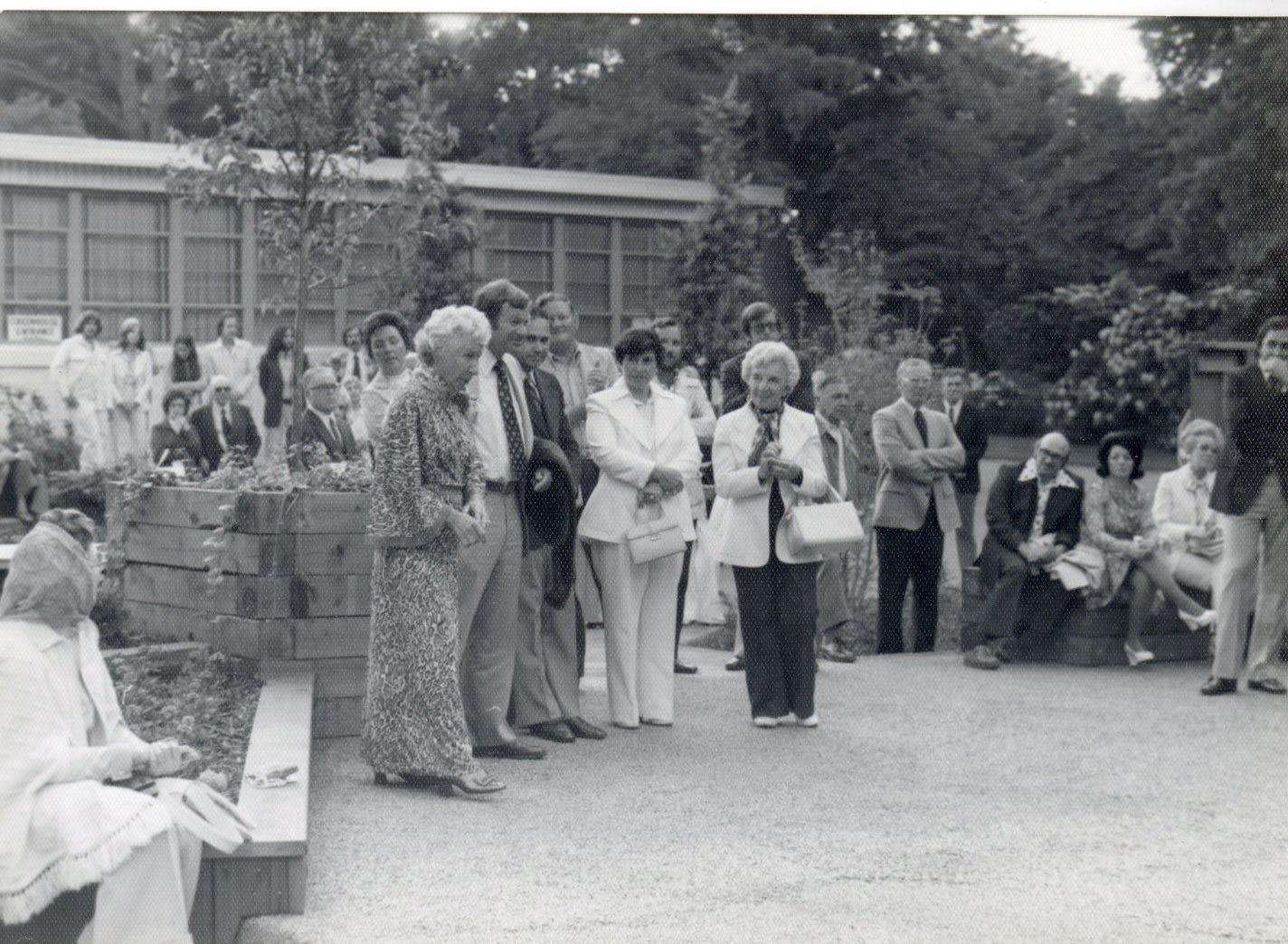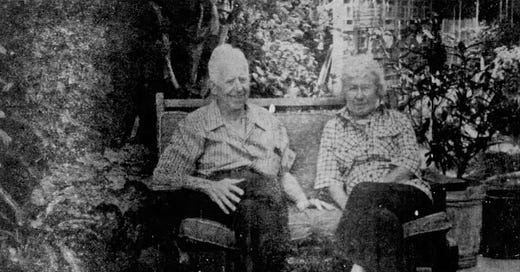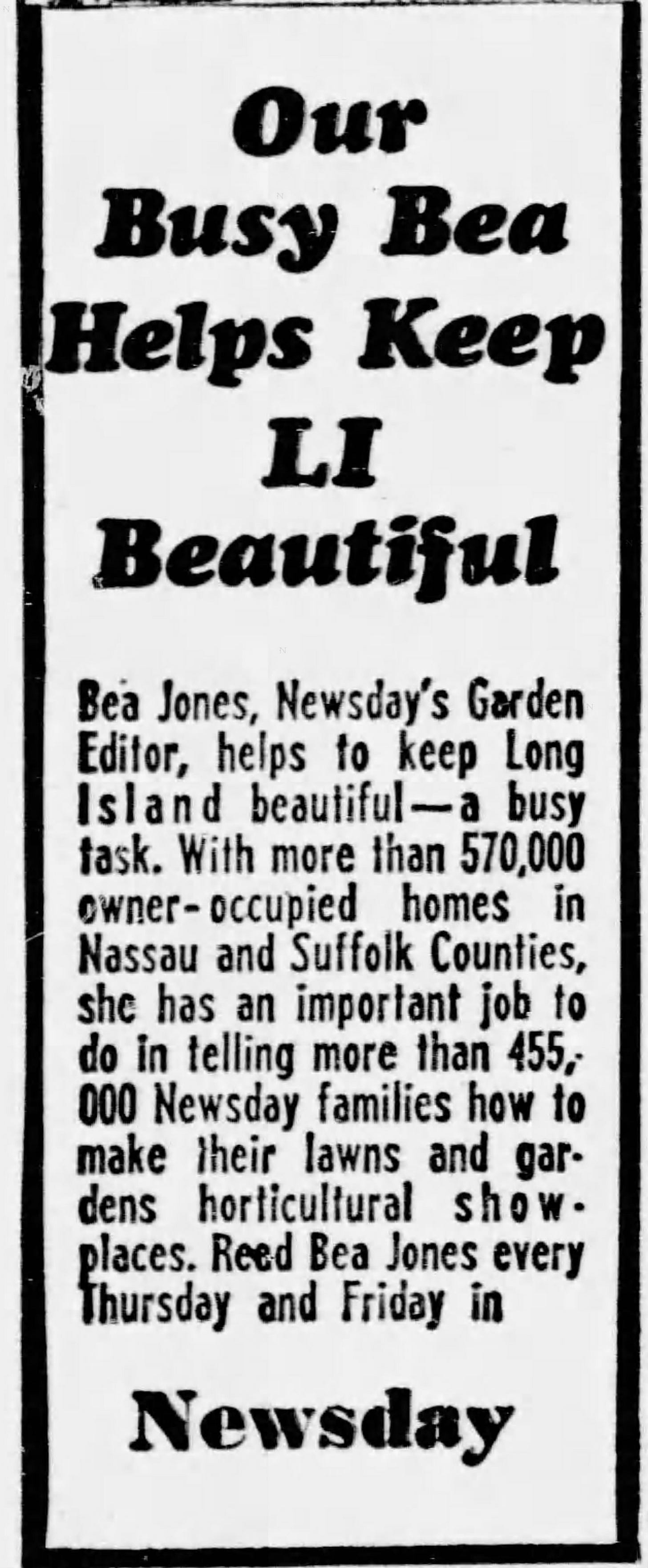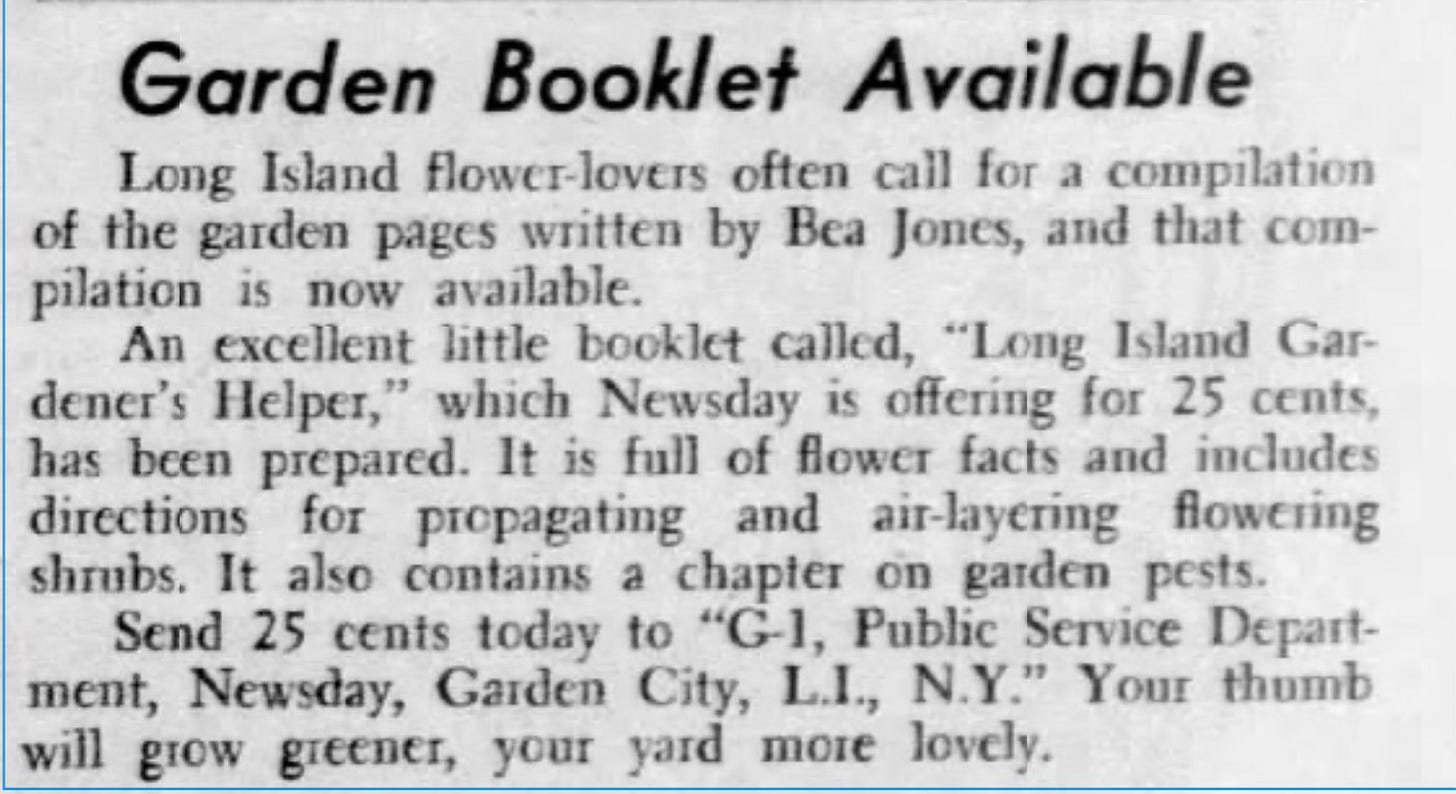When I discover a new-to-me Lost Lady of Garden Writing, rabbit holes open up all over the place. Should I explore her biography? What did she write? Why had I not heard of her? Does anyone still remember her? What old gardening tips can I glean from her writings?
And how did I find her, if she was lost?
In the case of Bea Jones, as I was looking over the pages of an old issue of Newsday, the byline for Bea Jones, Garden Editor, slid into view. I wrote down her name and started to do a few searches.
Her Biography
Unlike some Lost Ladies of Garden Writing, Bea’s obituary did appear in several newspapers, which gave me some basic biographical information. One reader sent me the obituary from the New York Times when she heard me mention my research about Bea Jones on a recent podcast episode.
Bea Jones, former garden editor of Newsday and a past president of the Garden Writers’ Association of America, died Saturday at her home in Palos Verdes Estates, Calif. The wife of Richard Wyse, a former Newsday editor, she moved there with him on his retirement in 1970 but continued to write her column until her own retirement last April. She was 69 years old.
Miss Jones was born Beatrice McCree in Brooklyn and attended Columbia University. She was on the editorial staff of the Nassau Daily Review‐Star before joining Newsday in 1944. But she did not become garden editor until 1951 when Alicia Patterson, the founder of Newsday, visited her Rockville Centre garden, now part of the Tanglewood Preserve.
She was a past vice president of the Newswomen's Club of New York.
Surviving are her husband; a son of a previous marriage, Ian Jones; a sister, Ada Mermann; and two grandchildren.
From a more extensive obituary in Newsday published on November 28, 1977, I discovered that prior to becoming the garden editor, she was a police and political reporter, and prior to that she was a co-author of Smash the Political Machine with Harold Rowntree, a book about political corruption in the 1930s. It was published under her maiden name of McCree in 1932.
From Ancestry, I learned that she was born on July 9, 1906, so she was actually 71 when she died. She married her first husband, Arthur Jones, around 1934, and they were divorced by 1940. Her only child, her son, was born in 1936 and died in 1995. Her second husband, Richard, died in 1978. I did notice that Ancestry showed a divorce record for her second husband issued in July 1977, but perhaps it wasn’t finalized when she died in November?
But I’m not here to speculate on her personal life. Let’s talk about her garden writing!
Her Garden Editing and Writing
In the article in Newsday announcing her death, she was acclaimed by several individuals including Peter Elston Costich, president of Horticulture Materials/Systems of Center Moriches and a garden researcher, who was quoted as saying, “She gave Long Island gardeners a goal to shoot for. She publicized gardening living and she really knew her stuff.”
Bea claimed that the newspaper “never had to print a retraction on my account” in her 24 years as the garden editor. But that didn’t mean that everyone agreed with her. I read some interesting letters to the editor in the early 70s, refuting her claims that gardening with chemicals was better than organic gardening. She answered right back, standing up for using chemicals. I think and hope she’d have a different view today, but we’ll never know.
Her weekly columns and articles covered a wide variety of topics. In 1972, for example, she wrote about bottle gardening, which was simply keeping rooted cuttings growing in water (not unlike the peace lilies sold in vases that were popular several years ago). She also introduced me to a houseplant called a “parlor linden,” Spartmannia africana, which was “grown in every German home for its dense hairy foliage and heavy heads of white flowers.” Ever hear of it? I hadn’t, and good luck finding it now.
Steadily and faithfully, through all seasons and even after she moved from Long Island to California, she wrote her column and served as the garden editor for 24 years.
Books?
Bea didn’t publish any books about gardening, as far as I can find (or rather not find.) However, there was an advertisement in the newspaper for a booklet.
Her Legacy
In 1976, a memorial garden named for Bea Jones was established at Planting Fields. Per her obituary in Newsdays (Suffolk Edition):
“The 5,000-square-foot garden, designed by five landscape architects, honors Jones, who is credited with helping saving Planting Fields when it was threatened by a shortage of money. When the State Legislature transferred the arboretum from the State University to the Long Island State Park Commission budget in 1971, the changeover resulted in inadequate funds to heat the greenhouses, and the arboretum was threatened with closing. Jones’s warnings of the danger to “an irreplaceable garden treasure” led to the formation of the Friends of Planting Fields, which raised $20,000 to buy heating fuel. The Legislature incrated the budget.”
Marie Penny, Michael D. Coe Archivist, Planting Fields Foundation, sent me two pictures taken of Bea at the dedication.


In a 1981 issue of Newsday, they also had an article about the “winner of the Bea Jones Memorial Trophy for excellence in overall garden design,” which was presented by Newsday “in memory of its late garden editor.” I don’t know if that award is still given out. References to it online are scarce.
Finally, I found information on a daylily named ‘Bea Jones’ but I have no idea if it was named after her or another Bea Jones. It was introduced in 2014, so I tend to think it was another Bea Jones.
What happened to the Bea Jones Memorial Garden?
Vinnie Simeone, Director of Planting Fields Arboretum State Historic Park responded to my email asking about the garden which didn’t show up in any searches.
I have been at Planting Fields for 33 years, so do I have some information on the Bea Jones garden. I was told that Bea Jones really was a trailblazer, and she was the first garden editor at Newsday. She was part of a grass roots group that did indeed help to raise awareness and the funds necessary for the friends of Planting Fields to help the facility reopen to the public in 1971. I believe the Bea Jones garden was built by and with the support of the Long Island Nursery Association (now the Long Island Nursery and Landscape Association) and as you noted, several designers had a hand in creating the design. The original design was to create a rooftop garden on top of an existing root cellar to offer a pleasing garden with raised planters, overhead trellis work and arbors for patrons to sit and enjoy the beauty of the garden. Seasonal displays and hanging baskets were used to dress the garden in the spring, summer, and fall months. The garden was mostly made out of wooden timbers and woodwork for the arbors, walls, and planters. By the time I arrived in 1992, the garden was starting to decline and eventually needed to be renovated. By the mid 2000s, the wood construction was starting to decay, and the garden was closed due to safety concerns. Unfortunately the garden had deteriorated to the point it needed to be completely rebuilt.1
If you want to see where the garden was, you can look at this map and find G12, which is where the sensory garden is now. That’s where it was!
Look For That Booklet
I did do some searching through eBay to see if, by chance, someone had a copy of Bea’s gardening booklet for sale. Nothing came up, but that doesn’t mean copies aren’t out there. If you live on or around Long Island, like my garden writer friends Lee Miller and Jessica Damiano, who helped me with some of my research about Bea, keep an eye out for it at antique stores.
Do you know of other women authors of gardening-related books that I should research as Lost Ladies of Garden Writing? Send them my way via a comment or email!
And if you find these articles interesting and think others will, too, please share them and subscribe.
I’ll return with the next Lost Lady of Garden Writing article in two weeks, on March 5th. In the meantime, you can find me in several other places online: my website and blog, The Gardenangelists podcast, and my weekly newsletter, In the Garden With Carol.
Mr. Simeone also noted: “So New York State Parks collaborated with Peter Tilles, philanthropist and long time supporter of the arboretum, and the Planting Fields Foundation to raise the funds necessary to design and build a new garden in that area. This was part of a bigger project to create a state-of-the-art sensory garden in the same footprint of the previous garden, which would be ADA-compliant and able to accommodate patrons of all abilities. The footprint of the new garden was expanded beyond the one from the previous garden. The new sensory garden features elements that stimulate all of the senses, including touch, taste, sound, vision, and smell. This is done through plants that have tactile, aromatic, and edible qualities as well as a water feature and wind chimes that offer soothing sounds in the garden. Many of the plants are bird and pollinator friendly, adding to its allure and ability to excite patrons who love nature. This garden project was started in 2013 and completed in 2015.
The second phase was to totally renovate our main visitor parking lot, which is almost entirely permeable and ADA compliant so it compliments the sensory garden nicely. The parking lot features native, pollinator, and bird-friendly plants, energy-efficient lighting, and the ability to greatly reduce water runoff. All of these efforts were done to better utilize an underutilized space and create a more accessible site for patrons to benefit from. Today, the sensory garden is one of the largest and most unique in New York State.









Another intriguing garden lady! Thank you!
Awesome article! I thoroughly enjoyed reading it!